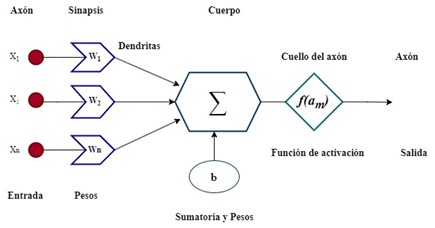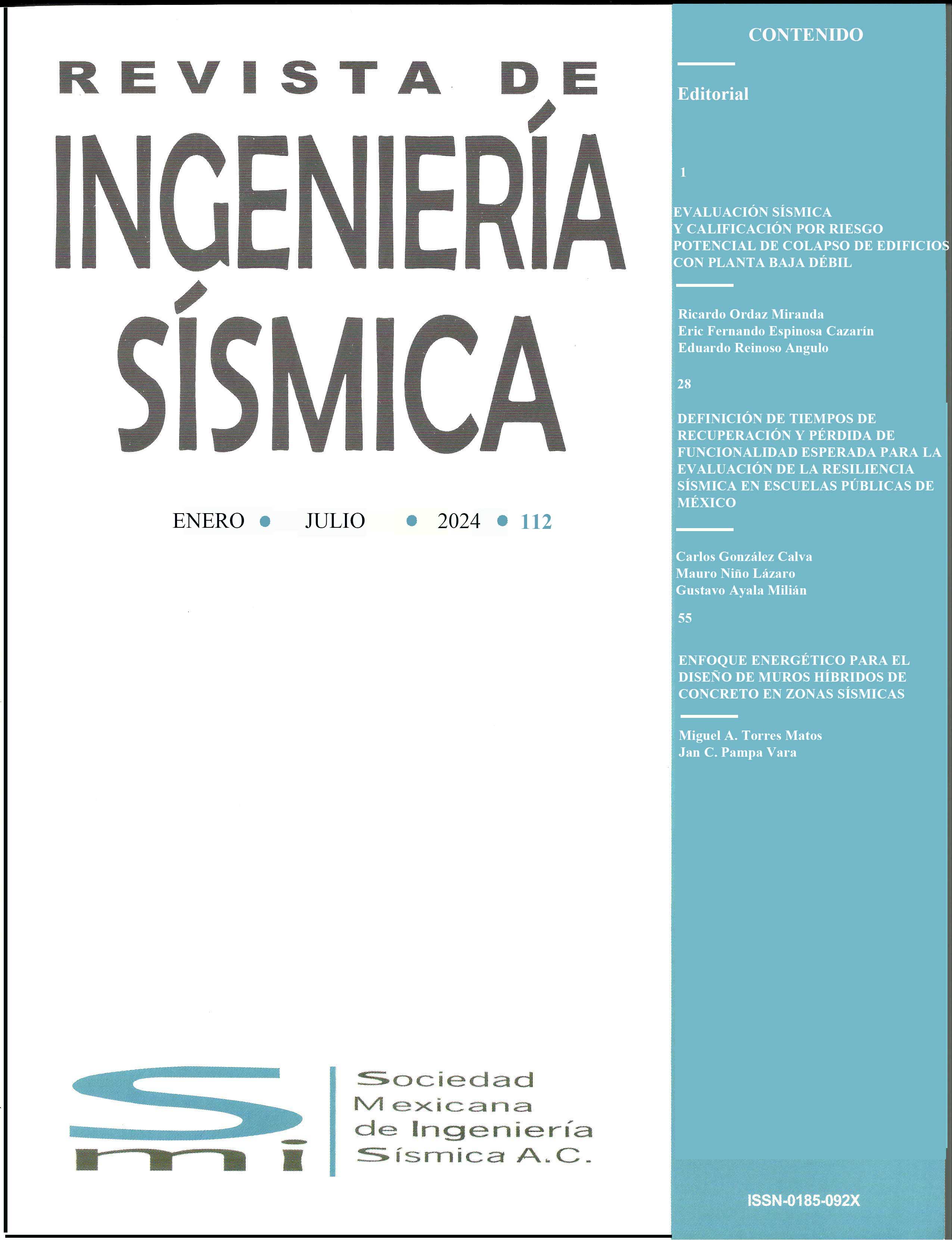PROPOSED SEISMIC LOAD COMBINATION FOR MEXICO CITY TAKING INTO ACCOUNT DIFFERENT SOIL TYPES
DOI:
https://doi.org/10.18867/ris.113.637Keywords:
concrete buildings, structural reliability, load factors, life cycle costs, artificial neural networksAbstract
This study addresses the impact of different soil types in Mexico City on the reliability and life cycle costs of reinforced concrete buildings using various proposed seismic load factors. The objective of this study is to propose the use of an optimal seismic load combination that improves the structural reliability for buildings of different levels, taking into account the life cycle costs. The methodology used is applied to reinforced concrete (R/C) buildings of 4, 6, 8, 8, 10, 12 and 15 stories located on different types of soils in Mexico City. Structural reliability and seismic performance are obtained using probabilistic methods that integrate the fragility curves and the annual exceedance rate of different damage states of the structure. To obtain the exceedance rates, artificial neural networks are used to simulate the structural demand hazard curves. A life cycle cost analysis of the structures is performed by integrating the initial cost and the costs of damage caused to the buildings in the face of possible future seismic demands. The life cycle costs obtained for the buildings designed with the building code load combinations, as well as the exceedance rates for the damage state equal to d=0.015, are compared against the costs and rates of the buildings designed with the seismic load combination of the analyzed building code. Finally, the optimal load combinations for the different soil types are obtained based on the analysis performed.
Downloads
References
Abdollahzadeh G., Omranian E. y Vahedian V. (2021), “Application of the artificial neural network for predicting mainshock-aftershock sequences in seismic assessment of reinforced concrete structures” Journal of Earthquake Engineering, 2021, vol. 25, no 2, p. 210-236. https://doi.org/10.1080/13632469.2018.1512062
Ang A. S. (2008), “Life-cycle considerations in risk-informed decisions for design of civil infrastructures”, Life-Cycle Civil Engineering. CRC Press, p. 23-30. https://dx.doi.org/10.1080/15732471003588239
Allahvirdizadeh R., Khanmohammadi M., y Marefat M. S. (2017), “Probabilistic comparative investigation on introduced performance-based seismic design and assessment criteria”, Engineering Structures, vol. 151, p. 206-220. https://doi.org/10.1016/j.engstruct.2017.08.029.
Asadi P. y Hajirasouliha I. (2020), “A practical methodology for optimum seismic design of RC frames for minimum damage and life-cycle cost”. Engineering Structures, vol. 202, p. 109896. https://doi.org/10.1016/j.engstruct.2019.109896
Asteris P. G. y Mokos V. G. (2020), “Concrete compressive strength using artificial neural networks. Neural Computing and Applications”, vol. 32, no 15, p. 11807-11826. https://doi.org/10.1007/s00521-019-04663-2
Bojórquez J. y Ruiz S. E. (2018), “Factores de carga óptimos para el diseño sísmico de edificios”. Ingeniería sísmica, no 98, p. 25-44. https://doi.org/10.18867/ris.98.505
Bojórquez J., Ruiz S. E., Ellingwood B., Reyes S. A. y Bojórquez, E. (2017), “Reliability-based optimal load factors for seismic design of buildings”, Engineering Structures, vol. 151, p. 527-539. https://doi.org/10.1016/j.engstruct.2017.08.046
Castaldo P., Palazzo B. y Della Vecchia P (2016), “Life-cycle cost and seismic reliability analysis of 3D systems equipped with FPS for different isolation degrees”, Engineering Structures, vol. 125, p. 349-363. https://doi.org/10.1016/j.engstruct.2016.06.056.
Carr A. J. (2007), “User manual for the 3D Dimensional Version” Ruaumoko 3D. Christchurch, University of Canterbury.
Chang W. y Zheng W. (2019), “Estimation of compressive strength of stirrup‐confined circular columns using artificial neural networks”, Structural Concrete, vol. 20, no 4, p. 1328-1339. https://doi.org/10.1002/suco.201800259
Cheng J. (2010), “An artificial neural network based genetic algorithm for estimating the reliability of long span suspension bridges”, Finite Elements in Analysis and Design, vol. 46, no 8, p. 658-667. https://doi.org/10.1016/j.finel.2010.03.005
CIRES, Centro de Intrumentación y Registros Sísmicos A.C., “Red Acelerográfica y Sistema de Alerta Sísmica de la ciudad de méxico”. Consultado: el 3 de abril de 2024. [En línea]. Disponible en: http://cires.org.mx/registro_busquedas_sismo_es.php
Cornell C. A. (1968), “Engineering seismic risk analysis”, Bulletin of the seismological society of America, vol. 58, no 5, p. 1583-1606. https://doi.org/10.1785/BSSA0580051583
De Leon D. E. (1996), “Integrating socioeconomics in the development of criteria for optimal aseismic design of R/C buildings”, PhD thesis, University of California, Irvine, USA.
Ellingwood B. R. (1994), “Probability-based codified design for earthquakes”, Engineering Structures, vol. 16, no 7, p. 498-506. https://doi.org/10.1016/0141-0296(94)90086-8
Ellingwood B. R. (1994), “Probability-based codified design: past accomplishments and future challenges”, Structural safety, vol. 13, no 3, p. 159-176. http://dx.doi.org/10.1016/0167-4730(94)90024-8.
El‐Khoury O., Shafieezadeh A. y Fereshtehnejad E. (2018), “A risk‐based life cycle cost strategy for optimal design and evaluation of control methods for nonlinear structures” Earthquake Engineering & Structural Dynamics, vol. 47, no 11, p. 2297-2314. https://doi.org/10.1002/eqe.3069.
Esteva L. (1968), “Bases para la formulación de decisiones de diseño sísmico”, Tesis de Doctorado, Facultad de Ingeniería, UNAM, México.
Esteva L., D Campos y O Díaz-López (2011), “Life-cycle optimization in Earthquake Engineering”, Structure and infrastructure engineering, Vol. 7, pp. 3349. http://dx.doi.org/10.1080/15732471003588270
Federal Emergency Management Agency, FEMA-445 (2012), “Next-generation performance-based seismic design guidelines”, Program Plan for New and Existing Buildings, Washington DC.
Federal Emergency Management Agency, FEMA P-58-1 (2018), “Seismic Performance Assessment of Buildings”, Washington DC.
Foster S. J., Stewart M. G., Loo M., Ahammed M. y Sirivivatnanon V (2016), “Calibration of Australian Standard AS3600 Concrete Structures: part I statistical analysis of material properties and model error”. Australian Journal of Structural Engineering, vol. 17, no 4, p. 242-253. https://doi.org/10.1080/13287982.2016.1246793.
Goverment, Tokyo Metropolitan (1985), “Report in the Investigation of the Earthquake in Mexico”
Ierimonti L., Caracoglia L., Venanzi I. y Materazzi A. L. (2017),” Investigation on life-cycle damage cost of wind-excited tall buildings considering directionality effects”, Journal of Wind Engineering and Industrial Aerodynamics,vol. 171, p. 207-218. https://doi.org/10.1016/j. jweia.2017.09.020.
IINGEN, Instituto de ingeniería UNAM, “Base de Datos de registros acelerográficos de la raii-UNAM”. Consultado: el 3 de abril de 2024. [En línea]. Disponible en: https://aplicaciones.iingen.unam.mx/ AcelerogramasRSM/RedAcelerografica.aspx.
INEGI (2020), “Encuesta nacional de ingresos y gastos de los hogares”.
Instituto de Ingeniería UNAM (1985), “Efectos de los sismos de septiembre de 1985 en las construcciones de la Ciudad de México.
Jain A. K., Mao J. y Mohiuddin, K. M. (1996), “Artificial neural networks: A tutorial”, Computer, vol. 29, no 3, p. 31-44. 10.1109/2.485891
Kim J. J., Kim A. R. y Lee S. W. (2020), “Artificial neural network-based automated crack detection and analysis for the inspection of concrete structures” Applied Sciences, vol. 10, no 22, p. 8105. https://doi.org/10.3390/app10228105
Krogh A. (2008), “What are artificial neural networks?”, Nature biotechnology, vol. 26, no 2, p. 195-197.
Lagaros N. D. (2007), “Life-cycle cost analysis of design practices for RC framed structures”, Bulletin of Earthquake Engineering, vol. 5, no 3, p. 425-442. http://dx.doi.org/10.1007/ s10518-007-9038-1.
Matlab, Matlab toolbox, Windows. Natick, Massachusetts: The MathWorks, Inc, 2015.
McCulloch W. S. y Pitts W. (1990), “A logical calculus of the ideas immanent in nervous activity”, Bull Math Biol, vol. 52, no. 1–2, p. 99–115, DOI: 10.1007/BF02459570.
Miller T. R. (2000), “Variations between countries in values of statistical life” Journal of transport economics and policy, p. 169-188. https://www.jstor.org/stable/20053838
Mirzaeefard H., Mirtaheri M., y Hariri-Ardebili M. A. (2021). “Life-cycle cost analysis of pile-supported wharves under multi-hazard condition: aging and shaking”, Structure and Infrastructure Engineering, 2021, p. 1-21. https://doi.org/10.1080/15732479.2021.1940216
Mitropoulou C.C., Lagaros N. D., y Papadrakakis M. (2011), “Life-cycle cost assessment of optimally designed reinforced concrete buildings under seismic actions”, Reliability Engineering & System Safety, vol. 96, no 10, p. 1311-1331. http://dx.doi.org/10.1016/j.ress.2011.04.002.
NTC-CADE-23. (2023), “Normas Técnicas complementarias sobre Criterios y Acciones para el Diseño de Edificaciones”, Gaceta Oficial de la Cuidad de México, México.
NTC-DCEC-23. (2023), “Normas Técnicas complementarias para Diseño y Construcción de Estructuras de Concreto”, Gaceta Oficial de la Cuidad de México, México.
NTC-DS-23. (2023), “Normas Técnicas complementarias para Diseño por Sismo, Gaceta Oficial de la Cuidad de México”, México.
Noureldin M., y Kim J. (2021),” Parameterized seismic life-cycle cost evaluation method for building structures” Structure and Infrastructure Engineering, vol. 17, no 3, p. 425-439. https://doi.org/10.1080/15732479.2020.1759656
O’Reilly G. J., Monteiro R., Nafeh A. M. B., Sullivan T. J., y Calvi G. M. (2020), “Displacement-based framework for simplified seismic loss assessment. Journal of Earthquake Engineering, vol. 24, no sup1, p. 1-22. https://doi.org/10.1080/13632469.2020.1730272.
Orellana M. A., Ruiz S. E. y Bojórquez J. (2017)”, Influence of Local Soil Conditions on Optimal Load Factors for Seismic Design of Buildings. International Journal of Civil and Environmental Engineering, vol. 11, no 6, p. 724-728. doi.org/10.5281/zenodo.1130669
Orellana M. A., Ruiz S. E., Bojórquez J., Reyes S. A. y Bojórquez E. (2021), “Optimal load factors for earthquake-resistant design of buildings located at different types of soils”, Journal of Building Engineering, vol. 34, p. 102026. https://doi.org/10.1016/j.jobe.2020.102026
Pandey M. D. y Van Der Weide J. A. M. (2017), “Stochastic renewal process models for estimation of damage cost over the life-cycle of a structure”, Structural Safety, vol. 67, p. 27-38. https://doi.org/10.1016/j.strusafe.2017.03.002.
Reddy Chukka N. D. K, Natrayan L, y Mammo W. D. (2021), “Seismic fragility and life cycle cost analysis of reinforced concrete structures with a hybrid damper” Advances in Civil Engineering, vol. 2021. https://doi.org/10.1155/2021/4195161
Rubinstein R. Y. (1981), “Simulation and the Monte Carlo Method”, John Wiley and Sons.
Santiago W. C., et al. (2020). Reliability-based calibration of main Brazilian structural design codes. Latin American Journal of Solids and Structures, 17(01).
Sørensen J. D., Kroon I. B. y Faber M. H. (1994), “Optimal reliability-based code calibration”, Structural Safety, vol. 15, no 3, p. 197-208. http://dx.doi.org/10.1016/0167-4730(94)90040-X.
Srikanth, I, y Arockiasamy, M (2020), “Deterioration models for prediction of remaining useful life of timber and concrete bridges: A review Journal of traffic and transportation engineering (English edition)”, vol. 7, no 2, p. 152-173. https://doi.org/10.1016/j.jtte.2019.09.005
Surahman, A, y Rojiani, K B (1983), “Reliability based optimum design of concrete frames”, Journal of structural engineering, vol. 109, no 3, p. 741-757. https://doi.org/10.1061/(ASCE)07339445(1983)109:3(741).
Tabari M. R, y Sanayei H. R. Z. (2019), “Prediction of the intermediate block displacement of the dam crest using artificial neural network and support vector regression model”, Soft Computing, vol. 23, no 19, p. 9629-9645. https://doi.org/10.1007/s00500-018-3528-8
Tolentino D. y Ruiz S. E. (2013), “Time intervals for maintenance of offshore structures based on multiobjective optimization”, Mathematical Problems in Engineering, vol. 2013. http://dx.doi.org/10.1155/2013/125856.
Vamvatsikos D. Cornell C. A. (2002), “Incremental dynamic analysis”, Earthquake engineering & structural dynamics, vol. 31, no 3, p. 491-514. https://doi.org/10.1002/eqe.141
Vazirizade S. M., Nozhati S. y Zadeh M. A. (2017), “Seismic reliability assessment of structures using artificial neural network”, Journal of Building Engineering, vol. 11, p. 230-235. https://doi.org/10.1016/j.jobe.2017.04.001
Viscusi W. K. y Aldy J. E. (2003), “The value of a statistical life: a critical review of market estimates throughout the world. Journal of risk and uncertainty, vol. 27, no 1, p. 5-76. https://doi.org/10.1023/A:1025598106257
Viscusi W. K. y Gentry E. P. (2015), “The value of a statistical life for transportation regulations: A test of the benefits transfer methodology”, Journal of Risk and Uncertainty, vol. 51, no 1, p. 53-77. http://dx.doi.org/10.2139/ssrn.2460837
Vitiello U., Asprone D., Di Ludovico M. y Prota A. (2017), “Life-cycle cost optimization of the seismic retrofit of existing RC structures”, Bulletin of Earthquake Engineering, vol. 15, no 5, p. 2245-2271. https://doi.org/10.1007/s10518-016-0046-x
Wen Y. K. (2001), “Reliability and performance-based design”, Structural safety, vol. 23, no 4, p. 407-428. https://doi.org/10.1016/S0167-4730(02)00011-5
Wen Y. K. y Kang Y. J. (2001), “Minimum building life-cycle cost design criteria. I: Methodology”, Journal of Structural Engineering, vol. 127, no 3, p. 330-337. https://doi.org/10.1061/(ASCE)0733-9445(2001)127:3(330)

Downloads
Published
How to Cite
Issue
Section
License
Copyright (c) 2025 Journal of Earthquake Engineering

This work is licensed under a Creative Commons Attribution-NonCommercial 4.0 International License.





